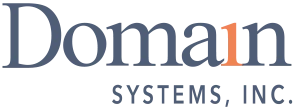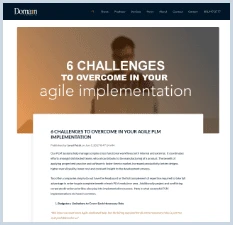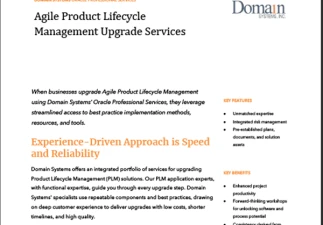Unlock the full potential of your product lifecycle with Domain Systems Oracle Agile upgrade services, where innovation meets efficiency.
Agile PLM Upgrade
Is It Time For An Agile PLM Upgrade?
Did you know that over one-third of implemented PLM solutions are over 5 years old? Delaying an upgrade opens the door to potential problems. Your platform could be at risk, and you may find yourself unsupported, leading to a complicated, expensive situation.
However, there’s no need to dread a system update. With the right approach, it can be a valuable project that ensures the continued success of your Agile PLM environment.
What happens when you upgrade Oracle Agile?

Leverage Agile PLM For Maximum Value
Unlock the value of upgrading your Agile PLM system with faster performance, expanded functionality, and improved security. Experience optimized data handling, seamless collaboration, and streamlined workflows, while safeguarding your critical product data with advanced security measures.

OUR PROCESS
Agile PLM Upgrade Methodology
Upgrading your Agile PLM system is a strategic move to unlock enhanced performance, functionality, and security. From initial planning and preparation to user acceptance testing and production environment upgrade, we cover every step to ensure a seamless transition.
“All of Domain Systems’ consultants and programmers were professional, thorough and flexible throughout each of our projects.”
We look forward to working with you.
Contact us now to schedule your personalized Agile PLM upgrade evaluation and propel your business towards success.
FAQ
Most frequent questions and answers
What is the Agile PLM Upgrade Service, and why is it essential for my business?
The Agile PLM Upgrade Service is a comprehensive offering that facilitates the seamless transition of your Agile PLM system to the latest version of 9.3.6.x. This service is essential to ensure your business benefits from the latest features, enhancements, and security updates, ultimately improving system performance and user experience.
Why should my business consider upgrading our Agile PLM system?
Upgrading your Agile PLM system is crucial to staying current with the latest technologies, security patches, and feature improvements. It allows your business to leverage enhanced functionality, address potential issues, and stay competitive in an ever-evolving business landscape. Version 9.3.6 is also the only Agile PLM version that is Premier Supported at this time.
How often should I consider upgrading Agile 9.3.6 with RUPs (release update patches)?
The frequency of Agile PLM upgrades can vary based on your business needs and the release schedule of the software provider. RUP changes are released based on a SCRUM development methodology with sprint changes coming as fast as every two weeks to every few months. Generally, it’s advisable to update to the latest RUP at least every 12 to 18 months to ensure your system remains up-to-date and benefits from the latest advancements and security patches.
Can the Agile PLM Upgrade Service handle customization and data migration during the upgrade process?
Yes, the Agile PLM Upgrade Service is equipped to handle customization and data migration. Our team will carefully assess your existing customizations and data structure, ensuring a smooth transition during the upgrade process. This includes validating and adjusting custom configurations to align with the new version.
How long does the Agile PLM Upgrade process typically take?
The duration of the Agile PLM Upgrade process depends on various factors, such as the complexity of your system, the volume of data, and any customizations involved. During the initial consultation, we will provide you with an estimated timeline based on your specific upgrade requirements. Client availability is critical during the upgrade process.
What level of testing is performed to ensure a smooth Agile PLM system transition after the upgrade?
The Agile PLM Upgrade Service includes comprehensive testing to ensure a smooth transition. Our team and the client interact together to conduct thorough testing of customizations, data migrations, and system functionalities to identify and address any issues before finalizing the upgrade. This proactive approach minimizes disruptions to your operations.




